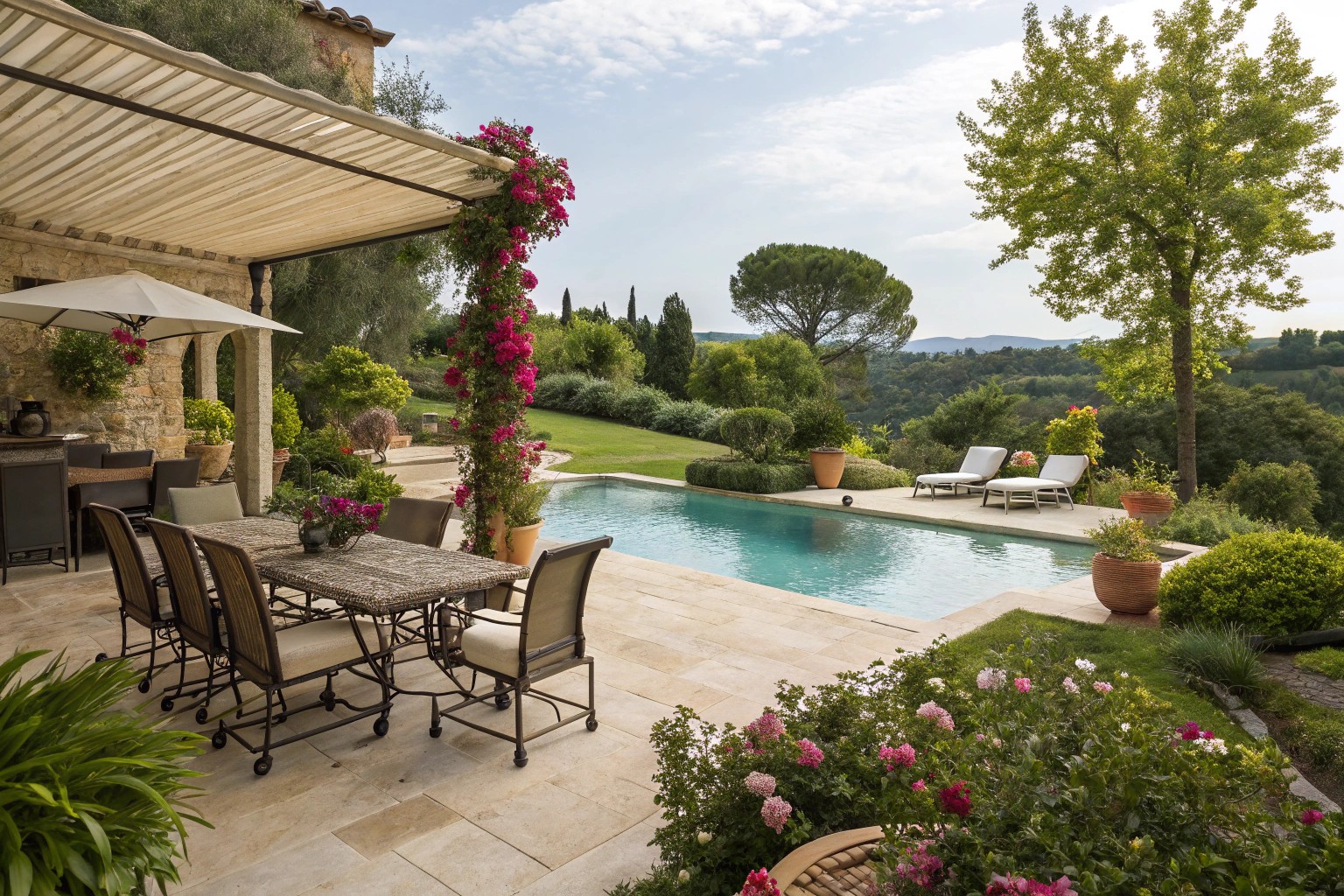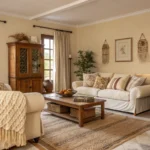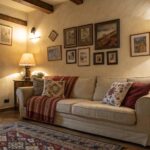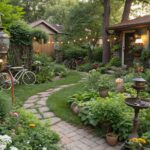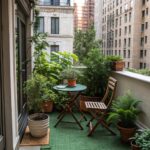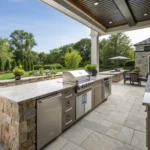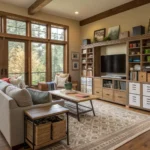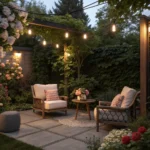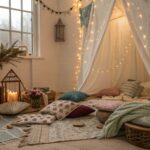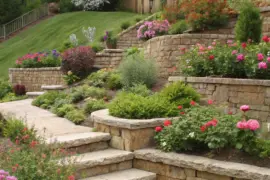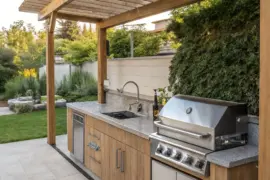Creating a vacation-inspired outdoor space requires more than beautiful plants and comfortable furniture—it demands understanding how resort environments work to transport us mentally and emotionally. Through strategic design choices, layered comfort elements, and thoughtful spatial planning, any outdoor area can become a personal retreat that delivers that coveted “getaway” feeling year-round.
Foundation: Creating Distinct Zones for Resort-Style Living

The hallmark of exceptional resort design lies in creating multiple functional zones that serve different purposes throughout the day. Rather than viewing your outdoor space as one large area, I approach each project by identifying natural divisions that can house specific activities.
Primary Zone Categories:
- Relaxation zone: Comfortable seating for reading, napping, or quiet conversation
- Entertainment zone: Dining areas and social gathering spaces
- Activity zone: Pool areas, games, or hobby spaces
- Transition zones: Pathways and buffer areas that connect different spaces
When working with clients, I often recommend the “resort flow” principle—guests should be able to move seamlessly between activities without feeling cramped or having to cross through other functional areas. This creates the psychological sense of spaciousness that defines luxury retreats.
Consider a rectangular backyard divided into three main zones: a dining area near the house for easy kitchen access, a central lounging area with comfortable seating, and a far corner dedicated to water features or gardens. The key is ensuring each zone feels purposeful and complete while maintaining visual connection to the others.
Essential Layout Strategies
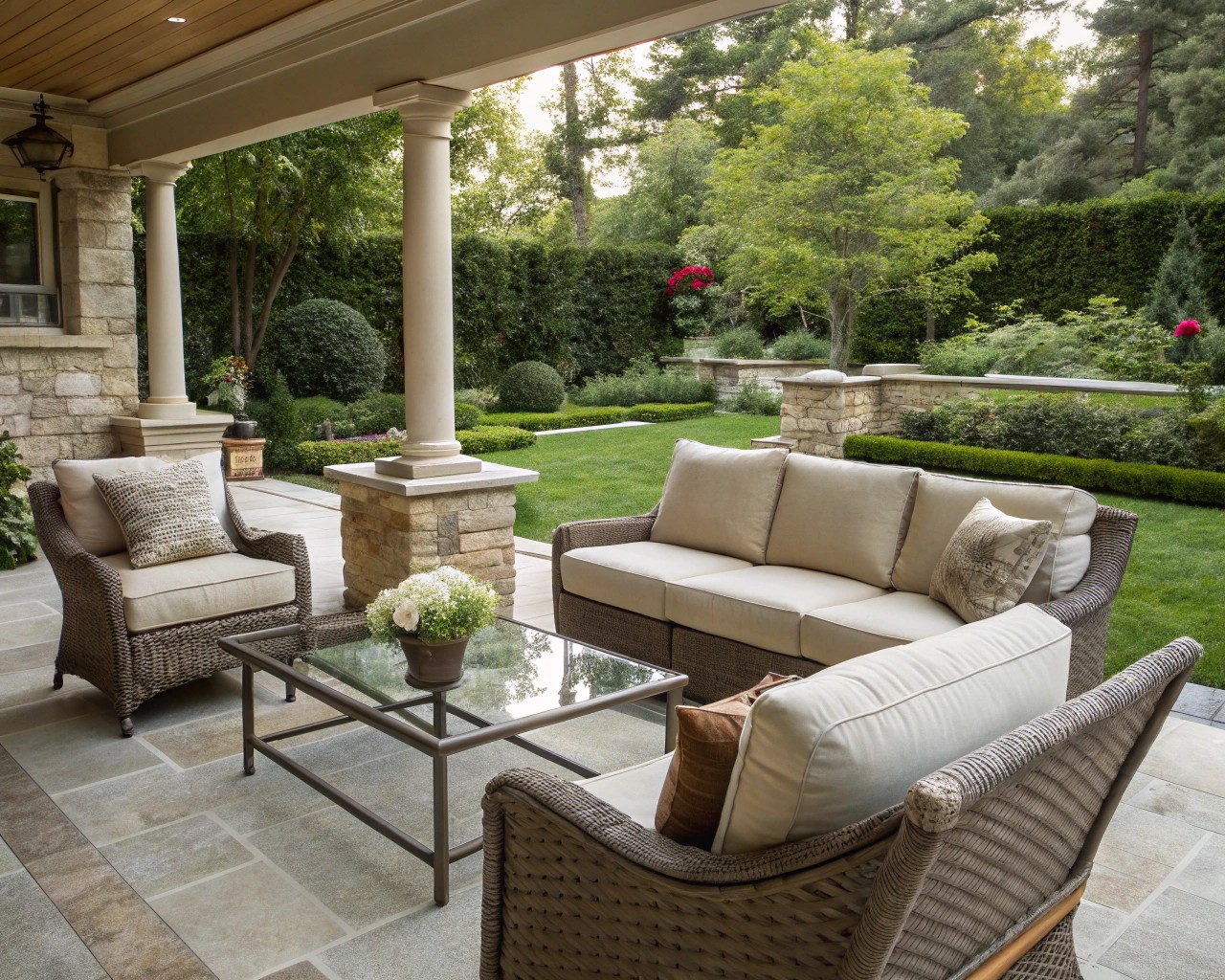
Traffic Flow Planning:
- Create curved pathways rather than straight lines to add visual interest
- Allow minimum 4-foot wide passages between major furniture groups
- Position high-use areas (dining, cooking) closest to interior access points
- Place quiet zones (reading nooks, meditation areas) furthest from activity centers
Scale and Proportion Guidelines:
- Small spaces (under 200 sq ft): Focus on one primary zone with multi-functional furniture
- Medium spaces (200-500 sq ft): Two distinct zones with clear visual separation
- Large spaces (500+ sq ft): Three or more zones with transitional elements between them
Water Features: The Heart of Resort Ambiance

Nothing transforms an outdoor space quite like the presence of water. Whether it’s the gentle trickle of a fountain or the expansive surface of a swimming pool, water features create both visual focal points and soothing soundscapes that mask urban noise and create tranquility.
Pool Design for Different Spaces:
| Space Size | Pool Option | Key Features |
|---|---|---|
| Large Backyard | In-ground infinity pool | Seamless edge, integration with landscape |
| Medium Space | Lagoon-style pool | Natural stone, curved edges, integrated spa |
| Small Space | Plunge pool or spa | Compact footprint, multi-season use |
| Rental/Temporary | High-quality inflatable | Quick setup, storage capability |
For spaces where permanent pools aren’t feasible, alternative water features provide similar benefits. A well-designed fountain can serve as a striking focal point while providing the crucial sound element. I particularly recommend tiered fountains or wall-mounted water features that maximize visual impact while minimizing space requirements.
Water Feature Maintenance Considerations:
- Choose features with appropriate filtration systems for your climate
- Consider solar-powered options for remote locations
- Plan for seasonal shutdown in freeze-prone areas
- Include adequate electrical supply during initial planning phases
Creating Lagoon-Style Atmospheres
One of my favorite approaches involves creating “lagoon pools” that incorporate natural stone, irregular shapes, and integrated landscaping. This design mimics tropical resort settings by blending the pool seamlessly with surrounding gardens. The key elements include:
- Natural stone coping: Travertine or flagstone instead of concrete
- Integrated planters: Built-in spaces for tropical plants around pool edges
- Varying depths: Shallow areas for lounging, deeper sections for swimming
- Rock formations: Strategic boulder placement for visual interest and seating
Tropical Landscaping: Bringing Resort Lushness Home

Resort environments consistently feature lush, layered plantings that create privacy, visual interest, and that essential “jungle paradise” feeling. The secret lies in understanding plant layering techniques and choosing species that provide year-round structure and seasonal interest.
The Three-Layer Planting Strategy:
Canopy Layer (8+ feet):
- Palm trees (Phoenix, Washingtonia species for warmer zones)
- Flowering trees (Crepe myrtle, bottlebrush for varied climates)
- Large specimen plants that create overhead interest
Mid-story Layer (3-8 feet):
- Large shrubs (hibiscus, bougainvillea in appropriate zones)
- Ornamental grasses (fountain grass, bamboo varieties)
- Architectural plants with bold foliage
Ground Layer (under 3 feet):
- Colorful annuals and perennials
- Ground covers and spreading plants
- Container gardens for seasonal flexibility
Climate-Appropriate Plant Selection:
For different USDA hardiness zones, tropical effects can be achieved through strategic plant choices:
- Zones 9-11: True tropical species (palm trees, hibiscus, bougainvillea)
- Zones 7-8: Hardy palms (windmill palm), banana plants, tropical-looking hardy species
- Zones 5-6: Annual tropical plants, containers that can be moved indoors, hardy plants with tropical appearance
Creating Privacy Through Strategic Planting
Privacy is essential for that secluded resort feeling. Rather than relying solely on fences, I use layered plantings to create natural screens that provide both privacy and beauty. Fast-growing options include:
Immediate Impact (1-2 years):
- Bamboo varieties (clumping types to prevent spreading)
- Fast-growing shrubs like forsythia or privet
- Annual vines on temporary trellises
Long-term Solutions (3-5 years):
- Evergreen hedges (boxwood, holly, cypress)
- Mixed shrub borders with varying heights
- Mature specimen trees for overhead canopy
Luxury Furniture and Comfort Elements
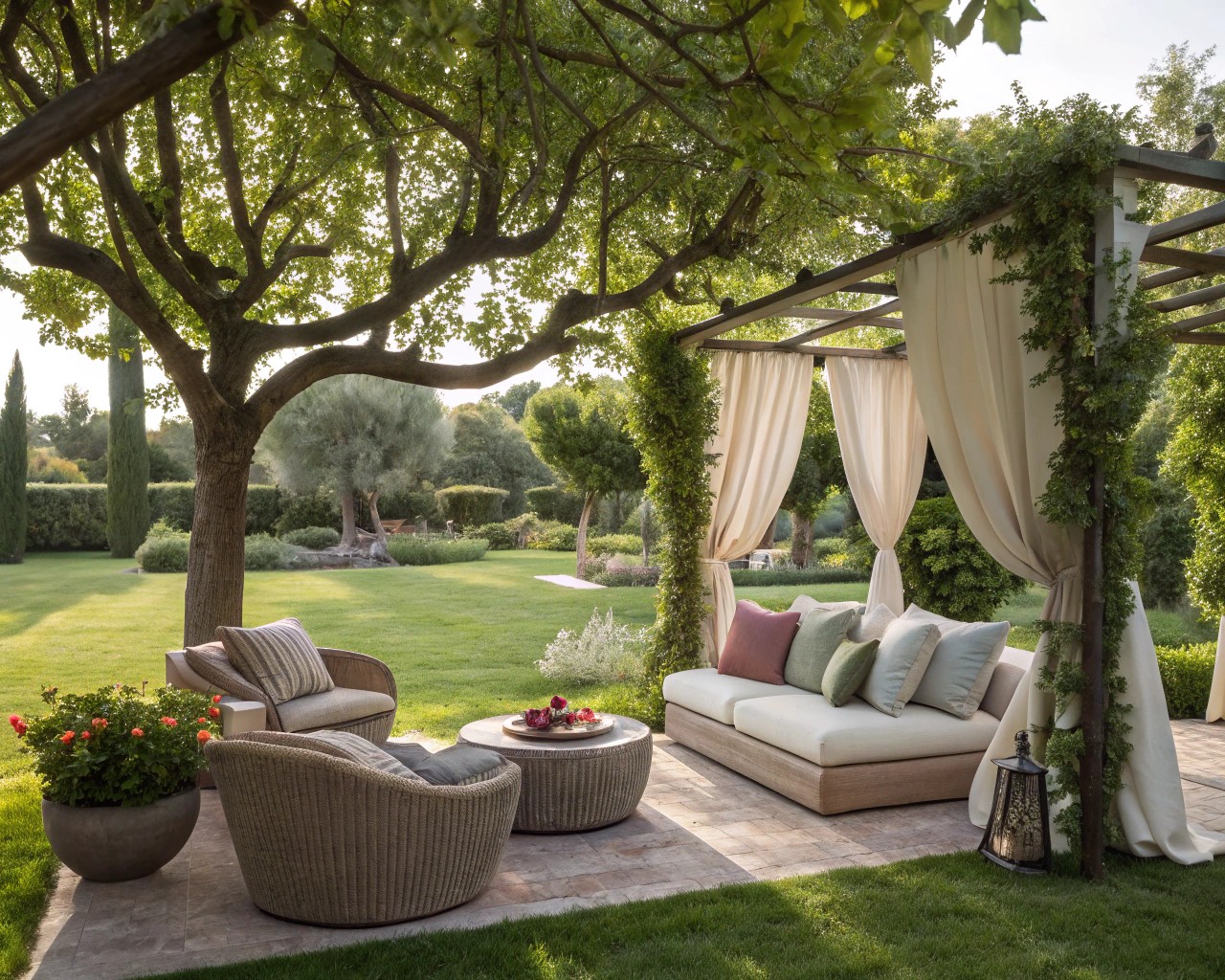
Resort-quality outdoor furniture must balance comfort, durability, and style. The goal is creating seating areas so inviting that they rival indoor living rooms in terms of comfort and functionality.
Material Selection Priorities:
1. Weather resistance: Aluminum frames, synthetic wicker, marine-grade fabrics
2. Comfort: Deep seating, quality cushions, ergonomic design
3. Maintenance: Easy-clean surfaces, removable cushion covers
4. Style longevity: Classic designs that won’t look dated in five years
Seating Configuration Strategies:
Conversation Areas:
- Circular or U-shaped arrangements promoting interaction
- Mixed seating heights (sofas, chairs, ottomans) for visual interest
- Central focal point (coffee table, fire feature, or water element)
Individual Retreat Spaces:
- Chaise lounges positioned for optimal sun/shade throughout the day
- Reading nooks with side tables and good lighting
- Hammocks or swing chairs in quiet corners
Dining Zones:
- Tables sized appropriately for typical entertaining (6-8 people most common)
- Mix of seating options (chairs, benches, built-in seating)
- Weather protection options (umbrellas, pergolas, retractable awnings)
Textile and Cushion Strategies
Outdoor textiles have evolved dramatically, with performance fabrics now offering the comfort of indoor materials with superior weather resistance. When selecting fabrics, I prioritize:
- Fade resistance: Solution-dyed acrylics perform best in direct sun
- Water repellency: Quick-dry foams and water-resistant covers
- Easy maintenance: Machine-washable covers, stain-resistant treatments
Color Psychology for Relaxation:
- Blues and greens: Promote calm and relaxation
- Warm neutrals: Create sophisticated, timeless appeal
- Coral and peach accents: Add warmth without overwhelming
- White and cream: Maximize light reflection and create spacious feeling
Lighting Design for 24-Hour Appeal
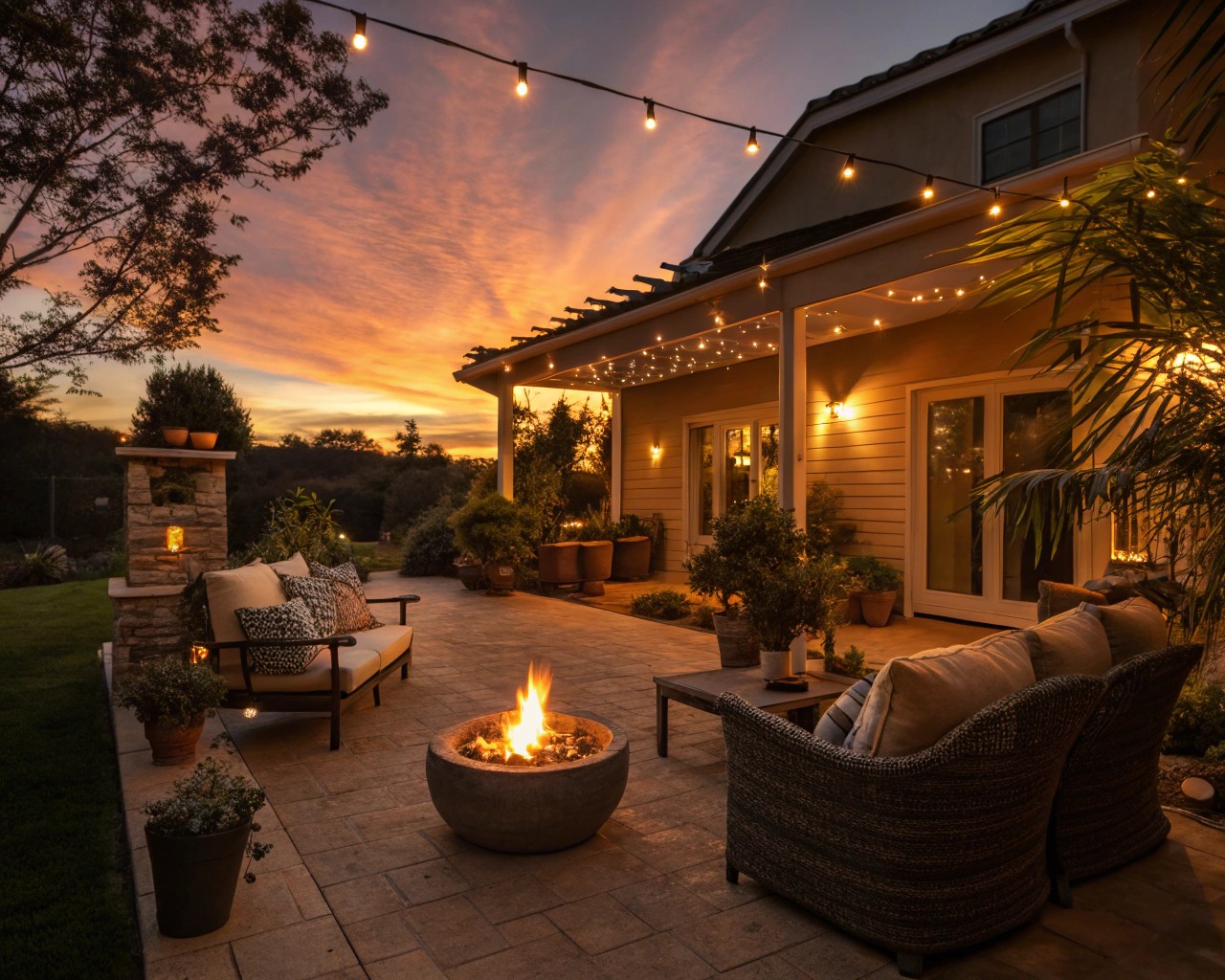
Professional lighting design extends the usability of outdoor spaces well into evening hours while creating the magical ambiance that defines luxury resorts. The key lies in layering different types of lighting to serve both functional and aesthetic purposes.
The Four Lighting Layers:
1. Ambient Lighting (Overall illumination):
- String lights suspended overhead for general area lighting
- Lanterns or pendant lights in covered areas
- Moonlighting effect from fixtures mounted in trees
2. Task Lighting (Functional illumination):
- Focused lighting for dining areas, outdoor kitchens, reading spaces
- Path lighting for safe navigation
- Accent lighting for steps and level changes
3. Accent Lighting (Visual interest):
- Uplighting for trees and architectural features
- Water feature illumination
- Garden lighting to highlight plantings
4. Decorative Lighting (Ambiance creation):
- Candles and lanterns for intimate settings
- Fire features for warm, flickering light
- Seasonal or special occasion lighting
Smart Lighting Integration
Modern outdoor lighting systems allow for sophisticated control and customization. Smart lighting offers several advantages:
- Programmable schedules: Automatic lighting based on sunset/sunrise
- Dimming capabilities: Adjustable intensity for different occasions
- Color changing options: Seasonal themes or special events
- Energy efficiency: LED technology with minimal power consumption
Installation Considerations:
- Plan electrical supply during hardscape installation
- Choose fixtures rated for outdoor use (wet location rated)
- Consider solar options for remote areas or eco-friendly operation
- Include adequate switching and control locations
Shelter and Shade Solutions
Comfort in outdoor spaces depends heavily on protection from sun, wind, and occasional precipitation. Successful resort-style design incorporates multiple shade solutions that serve different purposes throughout the day and seasons.
Permanent Shade Structures:
Pergolas and Gazebos:
- Provide defined overhead structure
- Support climbing plants for additional privacy
- Can incorporate retractable canopies for weather flexibility
- Create “outdoor rooms” that feel sheltered yet open
Architectural Awnings:
- Extend living space directly from house
- Retractable options for seasonal flexibility
- Can incorporate heating and cooling elements
- Professional installation ensures weather resistance
Flexible Shade Options:
| Solution | Best For | Pros | Cons |
|---|---|---|---|
| Market Umbrellas | Small seating areas | Easy repositioning, variety of sizes | Limited wind resistance |
| Cantilever Umbrellas | Pool areas, flexible zones | Large coverage, no center pole | Higher cost, base requirements |
| Shade Sails | Modern aesthetic, large areas | Dramatic visual impact, cost effective | Professional installation recommended |
| Retractable Canopies | Variable conditions | Weather flexibility, easy operation | Higher initial investment |
Climate-Responsive Design
Different regional climates require specific approaches to outdoor comfort:
Hot, Sunny Climates:
- Maximum shade coverage (70-80% of space)
- Light-colored materials to reflect heat
- Cooling features (misters, fans, water elements)
- Heat-resistant plant selections
Variable Season Climates:
- Retractable or removable shade options
- Multi-season furniture storage solutions
- Heating elements for cool evenings (fire pits, patio heaters)
- Covered areas for rain protection
Windy Locations:
- Wind-resistant furniture (low profile, heavy construction)
- Strategic placement of windbreaks (screens, plants, structures)
- Secure mounting for umbrellas and temporary structures
Outdoor Cooking and Dining Excellence
The outdoor kitchen has become the centerpiece of luxury outdoor living, transforming simple grilling into sophisticated culinary experiences that rival indoor cooking capabilities. Professional-grade outdoor kitchens require careful planning for both functionality and integration with the overall design aesthetic.
Essential Outdoor Kitchen Components:
Cooking Equipment Tiers:
- Basic: Quality gas grill with side burner
- Intermediate: Built-in grill, refrigeration, prep sink
- Advanced: Full kitchen with pizza oven, warming drawers, ice maker
Counter and Storage Design:
- Materials: Natural stone, concrete, or marine-grade stainless steel
- Configuration: L-shaped or galley layouts for workflow efficiency
- Storage: Weather-sealed cabinets, roll-out drawers, vertical storage
I’ve found that successful outdoor kitchens follow the same work triangle principles as indoor kitchens—positioning the grill, sink, and refrigeration in an efficient triangle that minimizes steps during food preparation. The key difference lies in weatherproofing and ventilation considerations.
Dining Area Integration:
Table Selection Criteria:
- Size: Allow 24 inches per person for comfortable seating
- Materials: Teak, aluminum, or synthetic materials for durability
- Shape: Round tables promote conversation; rectangular tables accommodate more guests
Seating Flexibility:
- Combination of fixed and moveable seating
- Bench seating for space efficiency
- Bar-height areas for casual dining and food service
Entertainment and Service Features
Professional outdoor entertaining requires supporting infrastructure that makes hosting effortless:
Beverage Service:
- Outdoor refrigeration for drinks and food storage
- Ice makers for consistent supply
- Weather-protected bar areas with storage for glassware and supplies
Climate Control:
- Ceiling fans in covered areas for air circulation
- Misting systems for hot climate cooling
- Portable heaters or fire features for cool evening extension
Finishing Touches: Accessories and Ambiance Details
The difference between a well-designed outdoor space and a truly resort-like retreat often lies in the carefully selected accessories and finishing touches that create layered sensory experiences.
Textile Layering Strategy:
Outdoor Rugs:
- Define seating areas and add warmth underfoot
- Choose synthetic materials designed for weather exposure
- Size appropriately (front legs of furniture should sit on rug)
Pillows and Throws:
- Add color, texture, and comfort to seating
- Use performance fabrics or bring indoors during weather extremes
- Layer different sizes and textures for visual interest
Practical Luxury Additions:
Storage and Organization:
- Weather-sealed storage for cushions and accessories
- Rolling carts for flexible serving and bar setup
- Hooks and hangers for towels, tools, and accessories
Technology Integration:
- Weather-resistant sound systems for ambient music
- Charging stations for devices
- Wi-Fi extension for reliable connectivity
Sensory Enhancement Elements
Resort experiences engage all the senses, and successful outdoor design incorporates elements that appeal beyond just visual beauty:
Sound Management:
- Water features to mask urban noise
- Strategic plant placement to absorb sound
- Wind chimes or other pleasant sound elements
Fragrance Planning:
- Aromatic plants (jasmine, gardenia, herbs) near seating areas
- Citronella plants for natural insect deterrence
- Seasonal fragrance rotation through container plantings
Tactile Experiences:
- Varied textures in materials (smooth stone, rough wood, soft textiles)
- Temperature variety (cool water features, warm fire elements, comfortable seating)
Seasonal Adaptability and Maintenance Planning
Sustainable resort-style outdoor living requires planning for year-round functionality and reasonable maintenance demands. The most successful projects I’ve completed incorporate systems that adapt to seasonal changes while maintaining their appeal throughout the year.
Four-Season Design Strategies:
Spring Preparation:
- Deep cleaning of furniture and textiles
- Plant replacement and garden refreshment
- System maintenance (irrigation, lighting, water features)
Summer Optimization:
- Maximum shade deployment
- Cooling feature activation (misters, fans)
- Extended lighting for longer evening use
Fall Transition:
- Protective furniture covers or storage
- Seasonal plant changes for autumn interest
- Heating element preparation and testing
Winter Adaptation:
- Furniture protection or storage
- Water feature winterization in freeze-prone areas
- Reduced but maintained lighting for winter appeal
Maintenance Simplification
Low-Maintenance Material Choices:
- Synthetic wicker over natural materials
- Aluminum frames over steel (rust prevention)
- Composite decking over natural wood
- Automated irrigation systems over manual watering
Seasonal Task Organization:
| Season | Critical Tasks | Optional Enhancements |
|---|---|---|
| Spring | Clean/inspect all systems, refresh plantings | New seasonal accessories, upgraded technology |
| Summer | Regular cleaning, peak maintenance | Pool/water feature optimization |
| Fall | Winterization prep, storage organization | Seasonal decoration, fire feature prep |
| Winter | Covered storage check, minimal maintenance | Planning for next year’s improvements |

